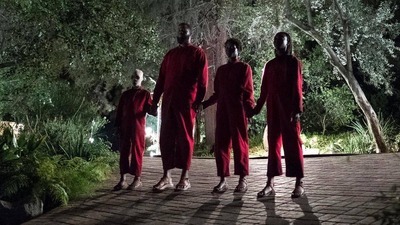Since “Get Out,” with greater and greater frequency, it has felt like Peele has needed to explain himself. But the premiere of “Us,” five years ago, marked a turning point for the director. Many wondered if Peele could come remotely close to matching the dexterity, impact, and influence of his culture shaking debut. “Us,” of course, not only received rave reviews, it set up even higher expectations for his third film “Nope.” Following that film’s unmitigated success—“Nope” became his third straight film to gross over $100 million at the domestic box office—it’s worth looking back at “Us,” not simply as the follow-up to “Get Out,” but as a standalone work that shaped the limited way we interpret Peele as an artist.
He is the shorthand for ‘Black Horror’. And with that title, he, along with those who have followed, have been boxed in by the expectations of the genre to be the emcee of our buried nightmares and our deepest fears, a shaman to explain the systemic horrors that have historically ailed us, the keeper of a code to be cracked for its importance rather than admired simply for its pure ability to thrill.
It’s why I hesitate to return to the Rubix Cube: After all, to place further emphasis on its meaning, would make me guilty of the same fever to strike symbolic gold from what could be a mundane choice. But return to the Rubix Cube I must: Consider how a television envelops the entire opening frame, until the camera pushes so far into its reflection that a young girl, Addy (Maddison Curry), is revealed sitting with her doll, a bunny. The year is 1986, and a commercial plays informing her and the viewer about “Hands Across America,” the misbegotten fundraiser asking people across the country to lock arms in a bid to fight hunger. Nestled around the television are VHS tapes of “The Man with Two Brains,” “The Goonies,” “Thursday Nites,” and ‘C.H.U.D.” (a sci-fi horror flick about mutated humans turned radioactive monsters living in the sewers). It’s worth noting that following the runaway success of “Get Out,” many critics and scholars used the films that influenced the director as an avenue to “explain” Peele and his arresting picture. Here, Peele is practically cutting them off at the pass, handing them a syllabus to solve the Rubix cube of a narrative he has tantalizingly nestled in the lower shelf.
The viewer is further stoked to search the frame in the film’s second scene: Addy and her parents are now at the Santa Cruz Beach Boardwalk. The camera pushes in again, this time not toward the image of Addy, but to Addy herself. There are two barrettes in her hair (one is pink and the other is blue). Her father (Yahya Abdul-Mateen II) hands her a prize, a “Thriller” t-shirt he’s won from a carnival game, as her exhausted mother (Anna Diop) looks on. Addy is a keen, wide-eyed child. She takes in the sights of zooming roller coasters and loving first dates, passing a man holding a sign saying “Jeremiah 11:11” as she wanders toward the beach and into a funhouse. She whistles as she explores the woodland themed hall and is surprised when she hears her melody, slightly distorted, returned by an unknown source. She comes to what seems like a mirror, except only the back of her head is reflected. Her eyes in horror widen; her mouth drops agape—the film cuts to a collection of white bunnies trapped in a wall of cages.

